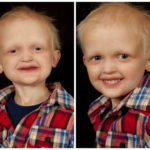
Meeting the dental needs of people affected by ectodermal dysplasias is as important as meeting their medical needs. Early dental treatment for the child without teeth is especially necessary. We advocate that children missing teeth get dentures by the time they start school, but children as young as 2 1/2 can successfully wear dentures.
Advantages of Proper Dental Treatment
Early dental treatment for the child without teeth is especially necessary. We advocate that children missing teeth get dentures by the time they start school, but children as young as 2 1/2 can successfully wear dentures. Listen to NFED Executive Director Mary Fete describe this crucial need.
There are a lot of benefits to dentures for children:
- Allows you to eat a wide variety of foods, improving nutrition
- Improves smiles
- Creates an age appropriate facial appearance, helping children to be accepted by their friends, families and others
- Improves speech – sounds such as “ch, th, and sh” are easier following dental treatment, making words more easily understood
- Stimulates tooth eruption when tooth buds are present
- Positively affects psychological and emotional well-being
To help you get started on this journey, download our guide to the dental treatment process. Our experts offer advice on when and where to begin, how to prepare your child, what to expect, what it costs, what to know about dentures and dental implants and more.
Download Our Dental Guide to Ectodermal DysplasiasDental Treatment Options
As Dr. Timothy Fete describes in the following clip, oral healthcare for individuals affected by ectodermal dysplasias is often a lifelong and expensive undertaking. As you determine your dental treatment path—from dentures to implants—be sure to explore our Treatment Assistance and Insurance Assistance programs to learn more about financing care.
Dental Treatment Centers
Having trouble finding the right dentist? We created a network of Dental Treatment Centers to help connect you with expert care.
Straumann Dental Implant Program
Straumann and the NFED work together to provide dental implants to families who demonstrate great financial need. Learn how to apply.
Dental Resources
Featured Download
The “Parameters of Oral Health Care” is a great document to provide to your dentist! We lay out the guidelines for healthcare professionals to manage the oral health problems of individuals affected by the ectodermal dysplasias. The guidelines are not intended to establish the standard of care, but to aid dentists and affected individuals in making informed choices about dental treatment. We give best practices for treatment for children, adolescents and adults.
Download Parameters of Oral Health CareDental Treatment Articles from Our Library
Don’t forget to browse our library for articles on teeth and oral care, including:

- Bonding
- How Are Dentures Made
- He’s Too Young for Dentures
- Taming the Angel in the Chair
- Dental Implants in Patients With Ectodermal Dysplasias
Dental Treatment Blogs
- Dental Treatment Shopping
- 8 Things You Should Expect From Your Dental Care Team
- Information to Take to Your Doctor or Dentist
- Treating Hypodontia in Children
- Things to Know When Your Child Needs Dentures
- Dentures for Kids
- 15 Ways to Help Your Child Get Ready for Dental Visits and Dentures
- Are Dental Implants Appropriate for Kids?
- Missing Teeth, Missing Benefits
Family Perspectives
You’re not alone. Hear from NFED families who have successfully navigated dental treatment options while living with ectodermal dysplasias. Consider joining us if you haven’t already!

“Keegan was diagnosed with HED at the age of 18 months. At 2, we consulted with Dr. Stanford and put together a plan for dental treatment. Keegan was nearly 3 years old when his first tooth finally poked through. We started the denture process shortly after. It never occurred to me that him living without teeth was even an option. By the time Keegan started preschool, he was wearing an upper denture all day, every day. He is very proud of his smile. Today, Keegan is the same age I was when I started to hate my smile because of my own missing and cone-shaped teeth. Unlike me, Keegan is full of confidence and his joyful – and toothy – smile is contagious and inspiring.” – Lindsey
- Keegan’s Denture Adventure Part I, Part II, Part III
- 4-Year-Old Wants to Bite Something With His New Dentures
- Transforming Me
- What I Learned from My Three-Year Dental Journey
- My Smile – 23 Years in the Making Part I, Part II, Part III
- A Mom’s Take on the Dental Implant Journey
- What a 10-Year-Old Girl With HED Wants Her Dentist to Know
- Watch Finley’s Denture Adventure
- Being Born Without Adult Teeth: From Resentment to Empowerment
- What I Would Tell My Middle School Self
- Longing for a Community of People Who Understand